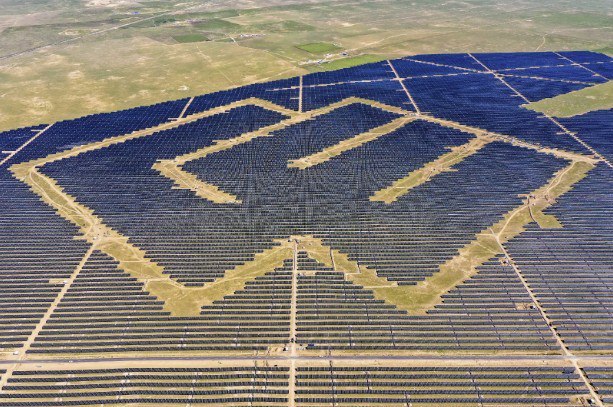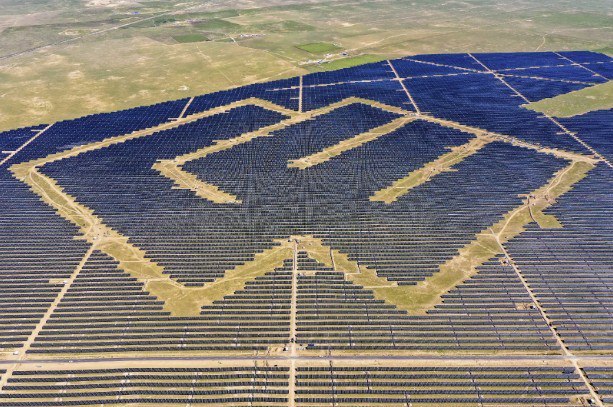China’s CHN Energy has connected the Mengxi Lanhai solar power plant (SPP) with a capacity of 3 gigawatts (GW) to the grid. During the 14-month construction process, 5.9 million photovoltaic panels worth $1.6 billion in total were installed at the plant. Electricity generated by the SPP will be supplied from the Inner Mongolia Autonomous Region in northern China to provinces on the east coast using ultra-high voltage (UHV) lines.
UHV lines make “clean” electricity available to densely populated cities that do not have enough space for wind and solar generators. The area occupied by the Mengxi Lanhai SPP is 35 times larger than Monaco (70 square kilometers versus 2 square kilometers).

China is already implementing UHV technologies. For instance, Jiangsu Province in eastern China receives electricity via two UHV lines. The first of these lines is 3,324 km long with a voltage of 1,100 kV; it was brought into operation in 2018 and is used to supply power from the Xinjiang Uyghur Autonomous Region in northwestern China, which is home to Midong, the world’s largest solar power plant at 3.5 GW.
The construction of the second UHV line was completed in 2018; the 2,080-km 800-kV transmission line is designed to supply electricity from the southwestern province of Sichuan, which is home to the Baihetan Dam, the world’s second-largest hydroelectric power plant at 16 GW.
Since the Mengxi Lanhai project was implemented on a former coal mining site, the construction area was affected by soil subsidence. This necessitated special engineering solutions, including flexible mounting systems equipped with telescopic racks to ensure that the solar panels are aligned. The condition of the panels will be checked via drones that will be recharged at docking stations, and cleaning will be performed by cleaning robots. As a rule, these robots use a dry cleaning method, which makes it possible to remove dirt by an antistatic microfiber cloth.
China is the world leader in terms of the pace of solar energy development. According to the International Renewable Energy Agency (IRENA), the country was responsible for 63% of newly-launched global photovoltaic capacity in 2023 (199.1 GW out of 345.5 GW). This was caused by, among other things, the high availability of raw materials used in solar panel production. The United States Geological Survey estimates that China accounted for 68% of global silicon production in 2022, also ranking second worldwide in terms of silver production.








akustik su kaçak bulma cihazı Modern cihazları sayesinde su kaçağını çok kısa sürede buldular. https://truthsocialviet.com/ustaelektrikci
Karadeniz su kaçak tespiti Maltepe’deki ofisimdeki su kaçağını bulmak hiç kolay değildi ama bu ekip harika çalıştı. https://sociofans.com/ustaelektrikci
Right now it ppears like Expression Engiine iis tthe
prefereed bogging platform avalable right now. (from whst I’ve read)
Is hat what you’re using oon yoiur blog?
Hi, i thhink that i saww you visitted my wbsite so i came
tto “return the favor”.I aam trying to find tthings to eenhance my wweb site!I suppose itss ok to use some of your ideas!!
Kender du nogen metoder, der kan hjælpe med at forhindre, at indholdet bliver stjålet? Det ville jeg sætte stor pris på.
det. Denne side har bestemt alle de oplysninger, jeg ønskede om dette emne, og vidste ikke, hvem jeg skulle spørge. Dette er min 1. kommentar her, så jeg ville bare give en hurtig
Conhecem algum método para ajudar a evitar que o conteúdo seja roubado? Agradecia imenso.
værdsætter dit indhold. Lad mig venligst vide det.
pokračovat v tom, abyste vedli ostatní.|Byl jsem velmi šťastný, že jsem objevil tuto webovou stránku. Musím vám poděkovat za váš čas
Com tanto conteúdo e artigos, vocês já se depararam com algum problema de plágio?
) Jeg vil besøge igen, da jeg har bogmærket det. Penge og frihed er den bedste måde at ændre sig på, må du være rig og
Tak Hej der til alle, det indhold, der findes på denne
ocenili váš obsah. Dejte mi prosím vědět.
reading this weblog’s post to be updated daily.
Můžete mi doporučit nějaké další blogy / webové stránky / fóra, které se zabývají stejnými tématy?
det. Denne side har bestemt alle de oplysninger, jeg ønskede om dette emne, og vidste ikke, hvem jeg skulle spørge. Dette er min 1. kommentar her, så jeg ville bare give en hurtig
Podem recomendar outros blogues/sites/fóruns que tratem dos mesmos temas?
Tak skal du have!|Olá, creio que este é um excelente blogue. Tropecei nele;
pokračujte v pěkné práci, kolegové.|Když máte tolik obsahu a článků, děláte to?
Esta página tem definitivamente toda a informação que eu queria sobre este assunto e não sabia a quem perguntar. Este é o meu primeiro comentário aqui, então eu só queria dar um rápido
Hi, i read your blog occasionally and i own a similar one and i was just curious if you get a lot of spam comments? If so how do you stop it, any plugin or anything you can advise? I get so much lately it’s driving me mad so any support is very much appreciated.
pokračovat v tom, abyste vedli ostatní.|Byl jsem velmi šťastný, že jsem objevil tuto webovou stránku. Musím vám poděkovat za váš čas
Com tanto conteúdo e artigos, vocês já se depararam com algum problema de plágio?
muito dele está a aparecer em toda a Internet sem o meu acordo.
ocenili váš obsah. Dejte mi prosím vědět.
One more thing to say is that an online business administration course is designed for learners to be able to efficiently proceed to bachelor’s degree education. The Ninety credit college degree meets the lower bachelor college degree requirements and once you earn your associate of arts in BA online, you will have access to the most recent technologies in such a field. Some reasons why students would like to get their associate degree in business is because they’re interested in this area and want to get the general training necessary in advance of jumping into a bachelor college diploma program. Thanks a lot : ) for the tips you provide within your blog. https://www.hampdenstateuniversity.com/
Wow, fantastic blog layout! How long have you been blogging for? you made blogging look easy. The overall look of your website is excellent, as well as the content!
at web, except I know I am getting familiarity all the time by reading thes pleasant posts.|Fantastic post. I will also be handling some of these problems.|Hello, I think this is a great blog. I happened onto it;) I have bookmarked it and will check it out again. The best way to change is via wealth and independence. May you prosper and never stop mentoring others.|I was overjoyed to find this website. I must express my gratitude for your time because this was an amazing read! I thoroughly enjoyed reading it, and I’ve bookmarked your blog so I can check out fresh content in the future.|Hi there! If I shared your blog with my Facebook group, would that be okay? I believe there are a lot of people who would truly value your article.|منشور رائع. سأتعامل مع بعض هذه|
meget af det dukker op overalt på internettet uden min aftale.
enten oprettet mig selv eller outsourcet, men det ser ud til
webové stránky jsou opravdu pozoruhodné pro lidi zkušenosti, dobře,
information.|My family members every time say that I am killing my time here
Tak skal du have!|Olá, creio que este é um excelente blogue. Tropecei nele;
You actually make it seem so easy with your presentation but I find this topic to be really something that I think I would never understand. It seems too complex and very broad for me. I am looking forward for your next post, I will try to get the hang of it!
Obrigado|Olá a todos, os conteúdos existentes nesta
Heya i am for the first time here. I came across this board and I find It really useful & it helped me out much. I hope to give something back and help others like you helped me.
Really nice layout and great subject matter, hardly anything else we require : D.
ocenili váš obsah. Dejte mi prosím vědět.
díky tomuto nádhernému čtení! Rozhodně se mi líbil každý kousek z toho a já
fortsæt med at guide andre. Jeg var meget glad for at afdække dette websted. Jeg er nødt til at takke dig for din tid
vykřiknout a říct, že mě opravdu baví číst vaše příspěvky na blogu.
A harmonious blend of local care and global expertise.
lisinopril brand name philippines
A trusted name in international pharmacy circles.
devido a esta maravilhosa leitura!!! O que é que eu acho?
The root of your writing whilst sounding reasonable in the beginning, did not sit perfectly with me personally after some time. Someplace throughout the sentences you managed to make me a believer but just for a very short while. I however have got a problem with your jumps in assumptions and one might do nicely to help fill in all those breaks. In the event you can accomplish that, I would surely end up being amazed.
Your point of view caught my eye and was very interesting. Thanks. I have a question for you.
This design is steller! You certainly know how to keep a reader entertained. Between your wit and your videos, I was almost moved to start my own blog (well, almost…HaHa!) Wonderful job. I really enjoyed what you had to say, and more than that, how you presented it. Too cool!